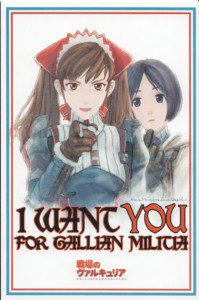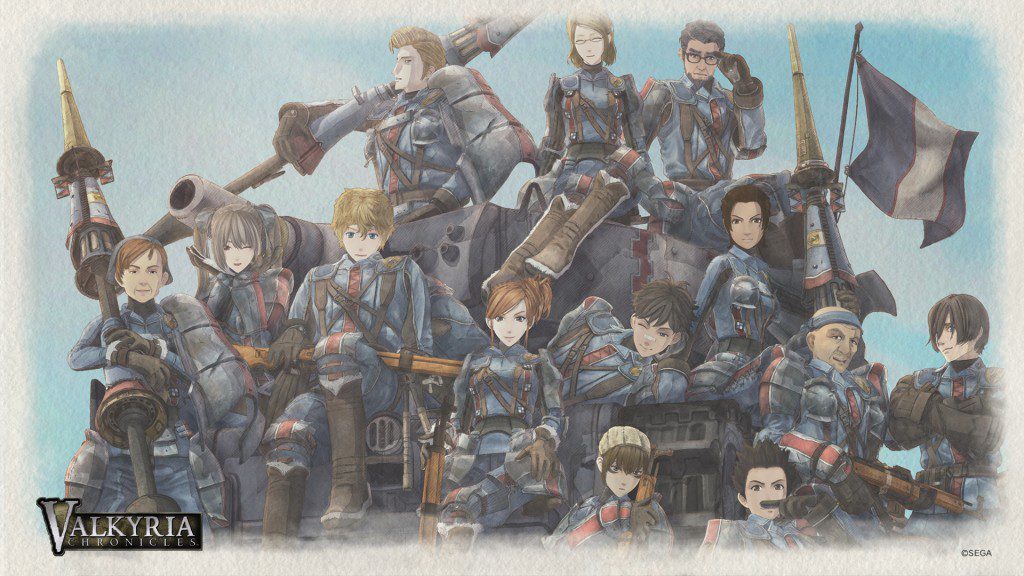One of the biggest sleeper hits of the seventh console generation has been Sega’s Valkyria Chronicles for the PlayStation 3. Produced by the creators of Sakura Wars and Skies of Arcadia, VC blends thematic and mechanical elements of both games. Valkyria Chronicles is easy to recommend to any fan of the SRPG genre, however, VC has elements that appeal beyond its genre. The game has been compared to the old X-COM strategy series for the PC, but it bears as much in common with contemporary cover-based shooters like Gears of War or Vanquish as it does with many SRPGs.

Valkyria Chronicles attracted attention immediately because of its unique visual style. Thematically and visually, Valkyria Chronicles looks like a SRPG that might have been designed by Hayao Miyazaki; in particular its theme and visuals seem inspired by Miyazaki’s Porco Rosso. Cel-shading is the computer graphictechnique that bridges the gap between the versatility of 2-D graphics and the immersion of 3-D graphics, and VC is a perfect illustration of this. In an age where so many designers are wandering the Uncanny Valley in search of the ultimate in graphics, Valkyria Chronicles shines in its unabashed embrace of comic-book visuals to tell a serious tale. Art Spiegelman understood this over 20 years ago with his critically acclaimed graphic novel Maus.
Valkyria Chronicles is set in a steampunk-fantasy version of WWII-era Europe. The western Atlantic Federation and eastern Imperial Alliance have declared all-out war on each other, with many smaller nations caught in the crossfire. Gallia, roughly analogous to the Low Countries of Belgium, the Netherlands, and Luxembourg, is one such country. You are Lt. Welkin Gunther, the commanding officer of Squad 7, an all-volunteer Gallian militia force. With the help of a ragtag group of volunteers ranging from townspeople to veterans of the previous war, each with their own personalities and prejudices, you must protect Gallia as the Empire tries to use it as a staging ground for an invasion of the Atlantic Federation.
Aside from its beautiful visuals, VC’s best feature is its battle engine. Most SRPGs are based on board game-style tile-based maps which give specific terrain bonuses. In contrast, VC is not confined to a “grid”, and during each character’s turn, they get a limited amount of “action points” to combine movement and attacking with as you see fit. This is similar to the Sakura Wars series, produced by the same developers. However, there are small but powerful changes that have taken this experience to the next level. Instead of a full overhead view of the action, when a character is selected, VC switches to that character’s point of view. Not only does this allow more immersion in the 3-D world, it also adds an edge of uncertainty to the battle. You no longer have the benefit of an omniscient view of the entire battlefield, and can only see and hear what is in the current character’s field of vision. This makes progression through a battlefield much dicier, as VC’s battles are loaded with enemy ambush points and charging blindly into the fray is a sure recipe for disaster, because enemies will be firing rifles at you even as you are advancing, and you can easily fall in battle during your own turn. Furthermore, taking a cue from some of this generation’s most popular games like Gears of War, awareness of the environment itself is a must, and you’ll need to make use of all the cover available, from walls to trees to tall grass, to keep from getting routed when it comes time for the enemy’s turn. In fact, in one mission, Welkin and Alicia, separated from the rest of Squad 7 and hopelessly outnumbered, must sneak past enemy soldiers and artillery without being seen. The game also features a number of spectacular vehicular battles. Each turn, you are given a number of “command points” to choose the characters you’ll use. Units can be used more than once a turn, although their performance diminished. Tanks consume more command points, limiting the use of other units. Even the use of CP is a strategic decision. Any CP you don’t use is saved up for the next turn, so you can use a few turns positioning only a few key units and save those CP for a major assault. Be warned, though – the enemy will do the same thing and your platoon can end up being overwhelmed. There are multiple bases to control, and you can switch out units mid-battle, as well as call for reinforcements to replace fallen units. Controlling bases allows you to bring in fresh units closer to the enemies. However, losing control of your “main base” will generally result in a Game Over.
[tube]bceYkhQjxGY[/tube]
There are five basic classes of character. Scouts are all-around soldiers with longer range than other classes so as to be able to get the layout of the battlefield. Shocktroopers are devastating close-range beasts with less range and poorer effectiveness at longer distances. Lancers, armed with rocket launchers, are important for taking out armor and fortified positions. Engineers are important for in-battle vehicle maintenance and disarming traps. Snipers, positioned in high places, can help thin out the enemy ranks from cover and make things easier for the ground infantry. Each of the playable characters has their own distinct personality, and these personality traits come into play in battle. Every character has positive and negative “potentials”, modifiers which are triggered when certain conditions, i.e. environmental, enemies, friends, are met. Unlike the “generic” solidiers in most other SRPGs, Sega WOW went out of its way to individualize every playable character’s appearance, personality, voice, and attributes, from Largo the lovable veggie-loving oaf to Rosie, the former cabaret girl struggling to overcome old prejudices. Welkin, the star of the show, is one of the best RPG heroes in recent memory – he’s heroic without being bland or corny, he’s not overly bishonen, and it’s clear that Squad 7 has a lot of respect for him as a commanding officer. They also have great foes to battle. In addition to the direct threat of the Empire and its leader, Maximillian, Gallia is also under assault from covert operations from the Atlantic Federation, which is analogous to the Allies of the real WWII. The standout villain is Selvaria Bleis, the female Valkyrur warrior whose visage graces the game’s cover art. The first time you see her in action, launching a horrific assault against your squad, you’ll develop a healthy respect for this dangerous opponent.
Valkyria Chronicles also deals with one aspect of World War II that most other games like Call of Duty won’t touch: racism. Racial politics colored almost every aspect of WWII, not just among the Axis powers, but among the Allies as well. In the Europe of Valkyria Chronicles, the Darcsens fill the role of Judaism, and the Darcsen sub-plot clearly mirrors many aspects of real-life anti-Semitism. Blamed for a terrible disaster at the dawn of history, the Darcsens are dehumanized and relegated to the lowest caste of society, not even allowed to take last names. The Valkyrur, in contrast, represent the “Aryan” race. A race of silver-haired sorcerers, it is the Valkyrur who supposedly suppressed the “Darcsen Calamity” with their lances of blue flame, and to this day, the Valkyrur are revered in Europa. Anti-Darcsen sentiment is as rampant in Gallia as anywhere else. Rosie, in particular, harbors a deep prejudice towards Darcsens, which causes considerable friction between herself and Welkin, who claims Isaara, a Darcsen, as a sister. It is later revealed that Rosie’s parents were killed harboring Darcsen fugitives from the authorities when she was a child, leading her to place irrational blame on the Darcsens for the loss of her family. One of the major battles of VC is a two-stage liberation of Fouzen, a major Darcsen concentration camp, which gives Rosie a first-hand look at the tragic results of anti-Darcsenism.
Valkyria Chronicles’ sound is a treat for the ears. Sega employed a number of well-known voice actors including Steve Blum, Hedy Burress, Kari Wahlgren, and Laura Bailey. There is no attempt to imitate the conventions of Japanese voice-acting, and unlike most other dubs, the voice acting is quite competent. Hitoshi Sakimoto, who composed the soundtracks for Final Fantasy Tactics and Final Fantasy XII, provided VC’s soundtrack. The music is fully orchestrated, with no electronic overtones at all as is common in today’s games. Whether in battle or during one of the game’s “slice-of-life” scenes, the music establishes the mood of every scene.
With Valkyria Chronicles, Sega used both Japanese and Western influences to push the SRPG genre forward from the template established by the SRPG gold standard, 1998’s Final Fantasy Tactics for the PS1. At the same time, they didn’t throw the baby out with the bath water in an effort to “modernize” as other Japanese developers have done in the HD generation. Valkyria Chronicles is what I’d hoped JRPGs would be in the HD era. This is a gem worthy of a place alongside in any PS3 library. If you haven’t picked this game up yet, at a going price of $20 at any Gamestop, now is a good time to start.



Another really great in depth review! Keep up the great work! <333